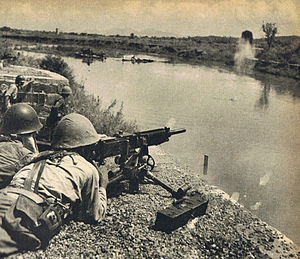4th Division (Imperial Japanese Army)
This article needs additional citations for verification. (December 2012) |
You can help expand this article with text translated from the corresponding article in Japanese. (December 2012) Click [show] for important translation instructions.
|
You can help expand this article with text translated from the corresponding article in Chinese. (July 2013) Click [show] for important translation instructions.
|
| 4th Division | |
|---|---|
 A soldier of the IJA 4th Division firing type 92 heavy machine gun during the 1st round of Chángshā operation. Near Miluo river (汨水), Húnán Province, China. | |
| Active | 1888 - 1945 |
| Disbanded | 1945 |
| Country | |
| Branch | |
| Type | Infantry |
| Size | Division |
| Garrison/HQ | Osaka City, Japan |
| Nickname(s) | Yodo Division |
| Engagements | First Sino-Japanese War Russo-Japanese War Siberian Intervention Shandong Incident World War II |
| Commanders | |
| Notable commanders | Takashima Tomonosuke Prince Kitashirakawa Yoshihisa Ichinohe Hyoe Abe Nobuyuki Terauchi Hisaichi Prince Higashikuni Naruhiko Tomoyuki Yamashita. |

The 4th Division (第4師団, Daiyon shidan) was an infantry division in the Imperial Japanese Army. Its call-sign was Yodo Division (淀兵団, Yodo-heidan) (from the Yodo River).
History
The 4th Division was formed in Osaka City in January 1871 as the Osaka Garrison (大阪鎮台, Osaka chindai), one of six regional commands created in the fledgling Imperial Japanese Army. The Osaka Garrison had responsibility for central region of Honshū (Kansai district), ranging from Shiga Prefecture to Hyōgo Prefecture. The six regional commands were transformed into divisions under the army reorganization of 14 May 1888.
Early action
The 4th regional command have played a vital role in the defeat of the Satsuma Rebellion in 1877.
During the First Sino-Japanese War in 1895, the 4th division has landed on Liaodong Peninsula and performed a security duties as part of army reserve, though its 7th Mixed Brigade was sent to northern Formosa in September 1895 during the Japanese invasion of Taiwan, and helped to pacify the Kapsulan (Yilan) district.[1]
During the Russo-Japanese War, the division, led by Lieutenant General Ogawa Mataji, participated in Battle of Nanshan, Battle of Liaoyang (where commander was wounded and replaced by Lieutenant General Tsukamoto Katsuyoshi), Battle of Shaho and the Battle of Mukden.
The division later served in the Siberian Intervention and the Jinan Incident (1928).
Action in Second Sino-Japanese War and Pacific War
On 10 February 1937, the 4th Division came under the command of the Kwantung Army in Manchuria. It was transferred to the 11th Army on 1 July 1940. It participated in Central Hubei Operation, Battle of South Henan, and Jiangbei operation (attacking from northern Anlu). In September 1941, the division participated in Battle of Changsha (1941). From 11 June 1941, it has started reorganization to triangular division, giving 70th infantry regiment to 425th division and eventually transferred to the active reserve force in the Japanese home islands.
In March 1942, the reorganization was complete and 4th Division was then reassigned to the 14th Army, arriving to Philippines to participate in the Battle of Bataan 3 April 1942 The 4th division also significantly contributed to Japanese efforts in the Battle of Corregidor 5 May 1942. After a Philippines Campaign (1941–42) ended 8 May 1942, the division was returned to home islands to perform a security duties.
It came under the control of the 25th Army in September 1943. It performed a garrison duties on Sumatra. Assigned to the 15th Army in 1945, its final headquarters was in Lampang, Thailand. It was disbanded at the end of World War II.
Memorial headquarters building
The original headquarters for the 4th Division was Osaka Castle. When the castle was reconstructed in 1931, a new headquarters building was erected within the castle grounds as short distance away by donations raised from the citizens of Osaka, so that the castle and its immediate surroundings could be made into a public park. In 1940, the headquarters moved again, this time to Hōkoku Shrine (Osaka) area.
The divisional arsenal in Osaka has detonated 14 August 1945 due Allied bombing, resulting in light damage to the headquarters buildings. By 2013, headquarters building remains as war memorial within the Osaka Castle Park.
Noted commanders in the history of the 4th Division have included Takashima Tomonosuke, Prince Kitashirakawa Yoshihisa, Ichinohe Hyoe, Abe Nobuyuki, Terauchi Hisaichi, Prince Higashikuni Naruhiko and Tomoyuki Yamashita.
Orders of battle
Order of battle, 1937, square division
4th Division
- 7th Infantry Brigade
- 8th Infantry Regiment
- 70th Infantry Regiment
- 32nd Infantry Brigade
- 37th Infantry Regiment
- 61st Infantry Regiment
- 4th Field Artillery Regiment
- 4th Cavalry Regiment
- 4th Engineer Regiment
- 4th Transport Regiment
Order of battle, August 1941, triangular division
4th Division
- 4th Infantry Brigade Group
- 4th Field Artillery Regiment
- 4th Reconnaissance regiment
- 4th Engineer Regiment
- 4th Transport (logistics) Regiment
- Signals company
- Ordnance workshop
- Sanitation company
See also
Notes
- ^ Davidson, The Island of Formosa, 353–4
Reference and further reading
- Madej, W. Victor. Japanese Armed Forces Order of Battle, 1937-1945 [2 vols] Allentown, PA: 1981
